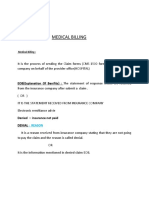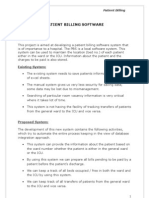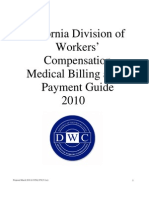100%(9)100% found this document useful (9 votes)
3K viewsMedical Billing
Medical Billing
Uploaded by
Ganesh D PandaMedical billing is the process of submitting claims to health insurance companies to receive payment for healthcare services. It involves assigning codes for procedures and diagnoses, transmitting claims electronically or on paper, addressing denied claims by making corrections and resubmitting, and ultimately receiving payment which may be reduced by insurance contractual rates, copays, deductibles, or coinsurance that patients are responsible for. Medical billers are encouraged to obtain certification to demonstrate their expertise in navigating this complex billing process between providers and insurers.
Copyright:
© All Rights Reserved
Available Formats
Download as DOCX, PDF, TXT or read online from Scribd
Medical Billing
Medical Billing
Uploaded by
Ganesh D Panda100%(9)100% found this document useful (9 votes)
3K views29 pagesMedical billing is the process of submitting claims to health insurance companies to receive payment for healthcare services. It involves assigning codes for procedures and diagnoses, transmitting claims electronically or on paper, addressing denied claims by making corrections and resubmitting, and ultimately receiving payment which may be reduced by insurance contractual rates, copays, deductibles, or coinsurance that patients are responsible for. Medical billers are encouraged to obtain certification to demonstrate their expertise in navigating this complex billing process between providers and insurers.
Original Description:
medical billing project report
Copyright
© © All Rights Reserved
Available Formats
DOCX, PDF, TXT or read online from Scribd
Share this document
Did you find this document useful?
Is this content inappropriate?
Medical billing is the process of submitting claims to health insurance companies to receive payment for healthcare services. It involves assigning codes for procedures and diagnoses, transmitting claims electronically or on paper, addressing denied claims by making corrections and resubmitting, and ultimately receiving payment which may be reduced by insurance contractual rates, copays, deductibles, or coinsurance that patients are responsible for. Medical billers are encouraged to obtain certification to demonstrate their expertise in navigating this complex billing process between providers and insurers.
Copyright:
© All Rights Reserved
Available Formats
Download as DOCX, PDF, TXT or read online from Scribd
Download as docx, pdf, or txt
100%(9)100% found this document useful (9 votes)
3K views29 pagesMedical Billing
Medical Billing
Uploaded by
Ganesh D PandaMedical billing is the process of submitting claims to health insurance companies to receive payment for healthcare services. It involves assigning codes for procedures and diagnoses, transmitting claims electronically or on paper, addressing denied claims by making corrections and resubmitting, and ultimately receiving payment which may be reduced by insurance contractual rates, copays, deductibles, or coinsurance that patients are responsible for. Medical billers are encouraged to obtain certification to demonstrate their expertise in navigating this complex billing process between providers and insurers.
Copyright:
© All Rights Reserved
Available Formats
Download as DOCX, PDF, TXT or read online from Scribd
Download as docx, pdf, or txt
You are on page 1of 29
1.
Medical billing is the process of
submitting and following up on
claims with health insurance
companies in order to receive
payment for services rendered by a
healthcare provider. The same
process is used for most insurance
companies, whether they are private
companies or government sponsored
programs.
3)
Medical billing is the process of
submitting and following up on
claims with health insurance
companies in order to receive
payment for services rendered by a
healthcare provider. The same
process is used for most insurance
companies, whether they are private
companies or government sponsored
programs. Medical billers are
encouraged, but not required by law,
to become certified by taking an
exam such as the CMRS Exam, RHIA
Exam and others. Certification
schools are intended to provide a
theoretical grounding for students
entering the medical billing field.
Contents
1 History
2 Billing process
o 2.1 Electronic billing
o 2.2 Payment
o 2.3 Medical billing services
3 See also
4 References
5 External links
History
For several decades, medical billing
was done almost entirely on paper.
However, with the advent of medical
practice management software, also
known as health information
systems, it has become possible to
efficiently manage large amounts of
claims. Many software companies
have arisen to provide medical
billing software to this particularly
lucrative segment of the market.
Several companies also offer full
portal solutions through their own
web-interfaces, which negates the
cost of individually licensed software
packages. Due to the rapidly
changing requirements by U.S.
health insurance companies, several
aspects of medical billing and
medical office management have
created the necessity for specialized
training. Medical office personnel
may obtain certification thro
ugh various institutions who may
provide a variety of specialized
education and in some cases award
a certification cre
dential to reflect professional status.
The Certified Medical
Reimbursement Speci
alist (CMRS) accreditation by th
e American Medical Billing
Association is o
ne of the most recognized of
specialized certification for medical
billing professionals.
Billing process
The medical billing process is an
interaction between a health care
provider and the insurance company
(payer). The entirety of this
interaction is known as the billing
cycle sometimes referred to as
Revenue Cycle Management. This
can take anywhere from several days
to several months to complete, and
require several interactions before a
resolution is reached. The
relationship between a health care
provider and insurance company is
that of a vendor to a subcontractor.
Health care providers are contracted
with insurance companies to provide
health care services. The interaction
begins with the office visit: a
physician or their staff will typically
create or update the patient's
medical record.
After the doctor sees the patient, the
diagnosis and procedure codes are
assigned. These codes assist the
insurance company in determining
coverage and medical necessity of
the services. Once the procedure
and diagnosis codes are determined,
the medical biller will transmit the
claim to the insurance company
(payer). This is usually done
electronically by formatting the claim
as an ANSI 837 file and using
Electronic Data Interchange to
submit the claim file to the payer
directly or via a clearinghouse.
Historically, claims were submitted
using a paper form; in the case of
professional (non-hospital) services
Centers for Medicare and Medicaid
Services. At time of writing, about
30% of medical claims get sent to
payers using paper forms which are
either manually entered or entered
using automated recognition or OCR
software.
The insurance company (payer)
processes the claims usually by
medical claims examiners or medical
claims adjusters. For higher dollar
amount claims, the insurance
company has medical directors
review the claims and evaluate their
validity for payment using rubrics
(procedure) for patient eligibility,
provider credentials, and medical
necessity. Approved claims are
reimbursed for a certain percentage
of the billed services. These rates
are pre-negotiated between the
health care provider and the
insurance company. Failed claims are
denied or rejected and notice is sent
to provider. Most commonly, denied
or rejected claims are returned to
providers in the form of Explanation
of Benefits (EOB) or Electronic
Remittance Advice.
Upon receiving the denial message
the provider must decipher the
message, reconcile it with the
original claim, make required
corrections and resubmit the claim.
This exchange of claims and denials
may be repeated multiple times until
a claim is paid in full, or the provider
relents and accepts an incomplete
reimbursement.
There is a difference between a
denied and a rejected claim,
although the terms are commonly
interchanged. A denied claim refers
to a claim that has been processed
and the insurer has found it to be not
payable. Denied claims can usually
be corrected and/or appealed for
reconsideration. A rejected claim
refers to a claim that has not been
processed by the insurer due to a
fatal error in the information
provided. Common causes for a
claim to reject include when personal
information is inaccurate (i.e.: name
and identification number do not
match) or errors in information
provided (i.e.: truncated procedure
code, invalid diagnosis codes, etc.) A
rejected claim has not been
processed so it cannot be appealed.
Instead, rejected claims need to be
researched, corrected and
resubmitted.
Electronic billing
A practice that has interactions with
the patient must now under HIPAA
send most billing claims for services
via electronic means. Prior to
actually performing service and
billing a patient, the care provider
may use software to check the
eligibility of the patient for the
intended services with the patient's
insurance company. This process
uses the same standards and
technologies as an electronic claims
transmission with small changes to
the transmission format, this format
is known specifically as X12-270
Health Care Eligibility & Benefit
Inquiry transaction.[1] A response to
an eligibility request is returned by
the payer through a direct electronic
connection or more commonly their
website. This is called an X12-271
"Health Care Eligibility & Benefit
Response" transaction. Most practice
management/EM software will
automate this transmission, hiding
the process from the user.
This first transaction for a claim for
services is known technically as X12837 or ANSI-837. This contains a
large amount of data regarding the
provider interaction as well as
reference information about the
practice and the patient. Following
that submission, the payer will
respond with an X12-997, simply
acknowledging that the claim's
submission was received and that it
was accepted for further processing.
When the claim(s) are actually
adjudicated by the payer, the payer
will ultimately respond with a X12835 transaction, which shows the
line-items of the claim that will be
paid or denied; if paid, the amount;
and if denied, the reason.
Payment
In order to be clear on the payment
of a medical billing claim, the health
care provider or medical biller must
have complete knowledge of
different insurance plans that
insurance companies are offering,
and the laws and regulations that
preside over them. Large insurance
companies can have up to 15
different plans contracted with one
provider. When providers agree to
accept an insurance companys plan,
the contractual agreement includes
many details including fee schedules
which dictate what the insurance
company will pay the provider for
covered procedures and other rules
such as timely filing guidelines.
Providers typically charge more for
services than what has been
negotiated by the physician and the
insurance company, so the expected
payment from the insurance
company for services is reduced. The
amount that is paid by the insurance
is known as an allowable amount.
For example, although a psychiatrist
may charge $80.00 for a medication
management session, the insurance
may only allow $50.00, and so a
$30.00 reduction (known as a
"provider write off" or "contractual
adjustment") would be assessed.
After payment has been made, a
provider will typically receive an
Explanation of Benefits (EOB) or
Electronic Remittance Advice (ERA)
along with the payment from the
insurance company that outlines
these transactions.
The insurance payment is further
reduced if the patient has a copay,
deductible, or a coinsurance. If the
patient in the previous example had
a $5.00 copay, the physician would
be paid $45.00 by the insurance
company. The physician is then
responsible for collecting the out-ofpocket expense from the patient. If
the patient had a $500.00
deductible, the contracted amount of
$50.00 would not be paid by the
insurance company. Instead, this
amount would be the patient's
responsibility to pay, and subsequent
charges would also be the patient's
responsibility, until his expenses
totaled $500.00. At that point, the
deductible is met, and the insurance
would issue payment for future
services.
A coinsurance is a percentage of the
allowed amount that the patient
must pay. It is most often applied to
surgical and/or diagnostic
procedures. Using the above
example, a coinsurance of 20%
would have the patient owing $10.00
and the insurance company owing
$40.00.
Steps have been taken in recent
years to make the billing process
clearer for patients. The Healthcare
Financial Management Association
(HFMA) unveiled a "Patient-Friendly
Billing" project to help healthcare
providers create more informative
and simpler bills for patients.
Additionally, as the Consumer-Driven
Health movement gains momentum,
payers and providers are exploring
new ways to integrate patients into
the billing process in a clearer, more
straightforward manner.
Medical billing services
In many cases, particularly as a
practice grows beyond its initial
capacity to cope with its own
paperwork, providers outsource their
medical billing process to a third
party known as a medical billing
service. These billing services
typically take a percentage of a
practice's revenues as payment.
One goal of these entities is to
reduce the burden of paperwork for
medical staff and to recoup lost
efficiencies caused by workload
saturation, paving the way for
further practice growth. Practices
have achieved significant cost
savings through Group purchasing
organizations (GPO), improving their
bottom line by 5% to 10%.[2]
Medical billing regulations also tend
to be complex and often change.
Keeping staff and billing systems up
to date with the latest billing rules
can become a distraction for health
care providers and administrators.
Another primary objective for a
medical billing service is therefore to
use its billing expertise and to focus
on maximizing insurances payments
by properly processing the provider's
claims. They are solely responsible
for taking codes from the coders and
preparing accurate bills that are
further forwarded to the insurance
company. It is the task of a medical
billing professional to complete the
billing process in a manner that it
will avoid denials from the insurance
companies.
Additionally, the recent trend in this
field towards outsourcing, has shown
a potential to reduce costs. In
addition, many companies are
looking to offer EMR, EHR and RCM
to help increase customer
satisfaction, however as an industry
the CSAT levels are still extremely
low
You might also like
- Medical Billing-Simple ManualDocument17 pagesMedical Billing-Simple ManualKarna Palanivelu80% (25)
- Medical BillingDocument10 pagesMedical Billingsensiva88452390% (143)
- Hospital Bill FormatDocument2 pagesHospital Bill Formatsandee191091% (11)
- JAFZA Warehouse Inspection ChecklistsDocument8 pagesJAFZA Warehouse Inspection ChecklistsPerwez21100% (1)
- Medical Billing TerminologiesDocument8 pagesMedical Billing Terminologiespriya_psalmsNo ratings yet
- Billing Training CompleteDocument141 pagesBilling Training CompleteBOBBILI50% (2)
- Internet Bill FormatDocument4 pagesInternet Bill Formatsachinjune79% (14)
- Medical BillingDocument5 pagesMedical BillingBenziger Fernandez90% (10)
- Medical BillingDocument16 pagesMedical BillingAbdul Gaffoor100% (8)
- Code Billing Heads Rate Quantity Amount in RsDocument2 pagesCode Billing Heads Rate Quantity Amount in RsPrasanna Nammalwar88% (32)
- Telephone Billing SystemDocument43 pagesTelephone Billing Systemsouravroyonline77% (35)
- The ManagerDocument2 pagesThe ManagerVholts Villa Vitug67% (3)
- Accident FormatDocument1 pageAccident FormatChinonye Brownie100% (2)
- Format of Medical Certificate 2015Document1 pageFormat of Medical Certificate 2015Satish Kumar100% (3)
- 028506.PDF Baker Model Ftd-040-Ee 29 PagesDocument29 pages028506.PDF Baker Model Ftd-040-Ee 29 Pagestomthumb1No ratings yet
- Medical BillingDocument16 pagesMedical Billingkishan rao100% (1)
- Medical BillingDocument229 pagesMedical BillingMohammad Apzar100% (8)
- US Medical Billing CycleDocument46 pagesUS Medical Billing Cycleanon_49916805580% (5)
- BillingDocument53 pagesBillingSourav Kumar0% (1)
- Payment Billing System DocumentDocument65 pagesPayment Billing System Documentshankar_718575% (8)
- Billing PlanDocument55 pagesBilling PlanSourav Kumar86% (7)
- Tablet FriabilityDocument25 pagesTablet FriabilityJean Florencondia67% (3)
- Restaurant OperationsDocument39 pagesRestaurant Operationsnahnah2001100% (1)
- BS 5516-1991 - Design & Installation of Sloping & Vertical 1Document70 pagesBS 5516-1991 - Design & Installation of Sloping & Vertical 1AlsonChin0% (1)
- Medical Billing ProcessDocument13 pagesMedical Billing ProcessUdayaKumar100% (6)
- Medical Billing - An OverviewDocument20 pagesMedical Billing - An OverviewKarna Palanivelu92% (13)
- Medical Billing TerminologiesDocument13 pagesMedical Billing TerminologiesSai Teja100% (2)
- Billing Definations 7Document15 pagesBilling Definations 7Saeed ahmed100% (2)
- Medical Billing TerminologyDocument49 pagesMedical Billing TerminologyBhuvana Bala100% (4)
- General Billing v2.0Document43 pagesGeneral Billing v2.0Anushiya Varadharaj100% (1)
- Medical Billing: EOB (Explanation of Benifits) : The Statement of Response Which We ReceivedDocument19 pagesMedical Billing: EOB (Explanation of Benifits) : The Statement of Response Which We Receivedjonnagadala surendrababu100% (1)
- Patient Billing SystemDocument44 pagesPatient Billing SystemYogesh Joshi75% (12)
- Billing ProcessDocument29 pagesBilling ProcessChandan Parsad100% (4)
- Billing Standards: Exchange Message Record (EMR)Document3 pagesBilling Standards: Exchange Message Record (EMR)extcengg4u67% (3)
- Patient Billing Software - SRSDocument16 pagesPatient Billing Software - SRSdivistar100% (6)
- Patient Billing & Account Receivable: Accident & EmergencyDocument11 pagesPatient Billing & Account Receivable: Accident & EmergencyIshak IbrahimNo ratings yet
- Standard Bill FormatDocument14 pagesStandard Bill FormatPrasanna Nammalwar100% (8)
- Medical Biller/collectionsDocument2 pagesMedical Biller/collectionsapi-77356174100% (4)
- Medical Billing and Coding SpecialistDocument2 pagesMedical Billing and Coding Specialistapi-77786926100% (4)
- Medical BillingDocument10 pagesMedical BillingKarna Palanivelu75% (4)
- BillingDocument6 pagesBillingMike SeoNo ratings yet
- Machine Billing FormatDocument10 pagesMachine Billing FormatSiva Kumarr100% (1)
- Accident - Hospital Billing Client Rino-1Document1 pageAccident - Hospital Billing Client Rino-1Dennis71% (7)
- BillingDocument15 pagesBillingTushar Borate0% (1)
- Billing BlockDocument58 pagesBilling BlockSourav Kumar100% (1)
- California Divison of Worker Compensation and Medical Billing & Payment GuideDocument176 pagesCalifornia Divison of Worker Compensation and Medical Billing & Payment Guidearunsanju78No ratings yet
- Balance Forwarding BillingDocument42 pagesBalance Forwarding Billingbreakinhrt6880100% (1)
- Billing FormatDocument1 pageBilling FormatParag KhandelwalNo ratings yet
- Fast Food Billing SystemDocument17 pagesFast Food Billing SystemShubham SinghalNo ratings yet
- BillingDocument38 pagesBillingrishikesh sahNo ratings yet
- Bill FormatDocument3 pagesBill FormatJhoana Parica Francisco100% (3)
- Good Morning I Love You: Maintaining Sanity & Humor Amidst Widowhood, Caregiving and Alzheimer'sFrom EverandGood Morning I Love You: Maintaining Sanity & Humor Amidst Widowhood, Caregiving and Alzheimer'sNo ratings yet
- Meeting Your Match Online: The Complete Guide to Internet Dating and Dating Services - Including True Life Date StoriesFrom EverandMeeting Your Match Online: The Complete Guide to Internet Dating and Dating Services - Including True Life Date StoriesRating: 3 out of 5 stars3/5 (2)
- Choose wise in relationship The first step in your marital lifeFrom EverandChoose wise in relationship The first step in your marital lifeRating: 2.5 out of 5 stars2.5/5 (2)
- Writing PL/SQL Executable StatementsDocument27 pagesWriting PL/SQL Executable StatementsGanesh D PandaNo ratings yet
- Medical CodingDocument41 pagesMedical CodingGanesh D Panda100% (1)
- Reports Study On Dematerialisation of SecuritiesDocument66 pagesReports Study On Dematerialisation of SecuritiesGanesh D PandaNo ratings yet
- Insurance Risk: Liability Insurance Is A Part of The GeneralDocument9 pagesInsurance Risk: Liability Insurance Is A Part of The GeneralGanesh D PandaNo ratings yet
- Kotak Life InsuranceDocument72 pagesKotak Life InsuranceGanesh D Panda100% (3)
- Iinformation and Technology in InsuranceDocument59 pagesIinformation and Technology in InsuranceGanesh D PandaNo ratings yet
- GarmentsDocument62 pagesGarmentsrobin shrv100% (2)
- Cement ManufacturingDocument4 pagesCement Manufacturinghijzain100% (1)
- 1941 Parkway Plan City Los Angeles Metropolitan AreaDocument61 pages1941 Parkway Plan City Los Angeles Metropolitan AreaJason BentleyNo ratings yet
- Designing and Managing Integrated Marketing Channels: PART V Delivering ValueDocument18 pagesDesigning and Managing Integrated Marketing Channels: PART V Delivering ValueUday SharmaNo ratings yet
- Table of ContentsDocument108 pagesTable of ContentsMuhammad Aabid HussainNo ratings yet
- Screw StrengthsDocument2 pagesScrew StrengthsFrank SandorNo ratings yet
- Brian Dobie Resume2Document2 pagesBrian Dobie Resume2api-282833800No ratings yet
- Managing Risk at The Pre Tender StageDocument6 pagesManaging Risk at The Pre Tender Stagedinu69inNo ratings yet
- Containers More: WWW - Csdubai.aeDocument12 pagesContainers More: WWW - Csdubai.aeganesh2020No ratings yet
- Hot Dip GalvanizingDocument3 pagesHot Dip Galvanizingapply19842371No ratings yet
- Sop Training LogDocument4 pagesSop Training LoguploaderNo ratings yet
- EEMUA Publications Catalogue May 2016Document5 pagesEEMUA Publications Catalogue May 2016malkaniravinderNo ratings yet
- 5 Unit NotesDocument6 pages5 Unit NotesCharanraj ParichendiNo ratings yet
- Sand Blasting Procedure-SNIPLDocument4 pagesSand Blasting Procedure-SNIPLSurendra Kumar Chordia100% (2)
- Types of Steel According To Deoxidation PracticeDocument2 pagesTypes of Steel According To Deoxidation PracticeSyed Raheel AdeelNo ratings yet
- CLE211 - Construction Management - 3Document24 pagesCLE211 - Construction Management - 3Moinak GhosalNo ratings yet
- BPR Assignment 1Document20 pagesBPR Assignment 1Uma KannanNo ratings yet
- International Aero Engines - WikipediaDocument7 pagesInternational Aero Engines - WikipediaSanooj N J KurupNo ratings yet
- Lifeboat Comparison SheetDocument9 pagesLifeboat Comparison SheetMohamed MostafaNo ratings yet
- Prashan Mantri Jeevan Jyoti Bima YojanaDocument2 pagesPrashan Mantri Jeevan Jyoti Bima YojanaRatsihNo ratings yet
- Channel ManagementDocument11 pagesChannel ManagementSureshkumar ThirunagalingamNo ratings yet
- Southwest Airlines AnalysisDocument5 pagesSouthwest Airlines Analysisसौम्या जैनNo ratings yet
- DBT 203 Metal Extractive Technology: Topic 1: Extracting Metal From OresDocument24 pagesDBT 203 Metal Extractive Technology: Topic 1: Extracting Metal From OresSollehah SuhaimiNo ratings yet
- Ins 21Document77 pagesIns 21Adithya KumarNo ratings yet
- Rural MarketingDocument20 pagesRural MarketingPriyanka LalwaniNo ratings yet































































































